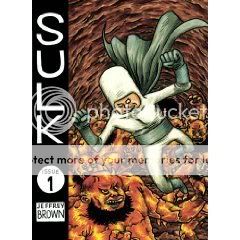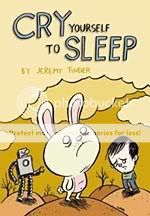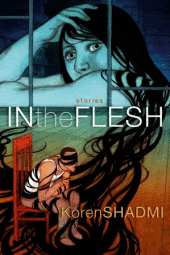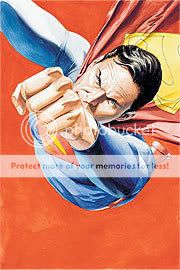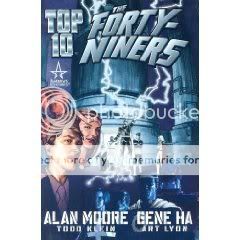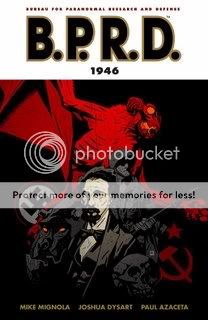Posts Tagged ‘Comics Time’
Comics Time: Sulk Vol. 2: Deadly Awesome
February 16, 2009Sulk #2: Deadly Awesome
Jeffrey Brown, writer/artist
Top Shelf, December 2008
96 pages
$10
The first thing you have to do when you read Jeffrey Brown’s all-MMA issue of his new one-man anthology title is disabuse yourself of any preconceptions the phrase “86-page fight scene” may engender. I myself was picturing a lengthy Frank Milleresque wordless slobberknocker, a showcase of action choreography. Brown had other ideas, particularly on the “wordless” score: Nearly every panel of the three-round bout between the veteran thinking-man’s-fighter Haruki Rabasaku and the charismatic bruiser Eldark Garprub is captioned or ballooned with a breakdown of their thoughts, moves, or both. Instead of dazzling us with pyrotechnics–the closest he ends up getting to that is with the very idea of the book itself–Brown uses the constant narrative jibberjabber to a) impress us with his devotee’s understanding of MMA, and b) slow time to a crawl, making each round feel like an hour’s worth of battle to the combatants. It’s an interesting move that dovetails with the story’s occasionally ruminative feel, particularly the abrupt, downbeat ending and the sensitive treatment of the two fighters’ slightly cheesy but nevertheless sincerely articulated worldviews. Now that I think of it, the vibe given off is akin to arthouse wire-fu flicks like House of Flying Daggers, not with that level of beauty of course, but in the way physical combat is treated as something both impressive and sad.
Comics Time: Sulk Vol. 1: Bighead & Friends
February 13, 2009Sulk Vol. 1: Bighead & Friends
Jeffrey Brown, writer/artist
Top Shelf, September 2008
64 pages
$7
For all its lo-fi provenance, Jeffrey Brown’s art has always felt rounded and tactile and full to me. His figures may have the disproportionately large heads and bendy arms of doodled cartoons, but they move around in environments you feel like you could swing through the panel into and explore; seeing one of his gridlike pages is like being presented with an array of tiny windows that way. Meanwhile there’s an emphasis on shading that reinforces the palpability of what he’s drawing. There really isn’t anything else, including (or perhaps especially) all the young cartoonists you see upon whom Brown is an obvious influence, that looks like it. It works a lot differently than, say, David Heatley’s stuff, despite the surface similarities you’d find between two guys who do lo-fi autobio comics with lots of little panels.
Bighead isn’t autobio, there aren’t a lot of little panels, and it’s only barely lo-fi, but all of the above still stands. In the past, this kind of parody work is the closest Brown has come to really showing off his chops, and that trend continues. All those penstroke shading lines frequently accrue into something rather lovely–the robotic arms of the Claw’s deathtrap, the darkness of “one of Chicago’s famous ‘indie rock’ shows,” the vortext that swallows the Author when he messes with reality a little too much.
Meanwhile the superhero parody gags made me laugh repeatedly, particularly the dialogue. Brown really nails overwrought, superhero house-style banter that makes it seem like its author doesn’t quite understand how to write. “This time you’ve gone too far, The Claw!” “I’m crazy? I’m crazy?! Don’t you know who you’re talking to? You’re talking to me!” There are equally effective sight gags, from the Superboy-like Little Bighead getting so emotional about the Pacifier’s rampage that he finally just breaks down and starts sucking on the vigilante’s rubber-nipple headgear to the opening splash page of Bighead crashing through a window with a caption reading “HOLY SHIT!” And then there’s the tragic tale of Beefy Hipster, driven to supercrime by his inability to fit into his favorite band’s American Peril t-shirts.
It’s a funny, intelligently drawn superhero humor comic, and usually you can only get one or the other, if anything, so if you want to laugh at superhero comics that actually are intriguing to look at, by all means check this out.
Comics Time: Scott Pilgrim Vol. 5: Scott Pilgrim vs. the Universe
February 11, 2009Scott Pilgrim Vol. 5: Scott Pilgrim vs. the Universe
Bryan Lee O’Malley, writer/artist
Oni Press, February 2009
192 pages
$11.95
The greatest trick Scott Pilgrim ever pulled was convincing you its conscience didn’t exist. For a long time, the series’ skeptics criticized the shortcomings of the characters as though their existence was a shortcoming of their creator–as though writer/artist O’Malley was unaware that Scott was kind of shiftless and feckless, or that Ramona Flowers was a little bit cruel and aloof, or that their group of friends was cliquey and catty. I definitely see where such critics are coming from, for a couple of reasons: first, that was pretty much my line of attack when I first read Jaime Hernandez’s Locas material (newsflash: Hopey’s a jerk and Maggie’s a mess!); second, I am now a 30-year-old married homeowner in Levittown, and the further I get from Scott’s situation, the harder it gets to relate to, or even in some ways really care about, his plight.
But over the past three volumes, O’Malley has slowly pulled back the operating curtain to reveal the beating heart of the series; if you’ll allow me to mix metaphors, what this means is that the chickens have been coming home to roost. It turns out that all those evil ex-boyfriends aren’t just plot devices, but people who’ve had a lasting effect on how Ramona lives. It turns out that Scott’s glibness both hurts his relationship(s) and enables him to see their potential when others can no longer do so. It turns out that Knives’s lasting crush on Scott isn’t just a funny recurring gag, but something that’s screwing up her life and causing her to screw up the lives of those around her. It turns out that all the “we suck”isms the band indulges in actually have power in a self-fulfilling prophecy kind of way. It turns out that supporting players have lives of their own and that they can really grow to dislike how oblivious the main characters are to that fact. And so on and so forth.
At the risk of saying what I say any time a new Scott Pilgrim comes out, the singular achievement of the series is conveying all this stuff through the visual language of video games, action comics, and shonen manga. By all means, let the evil ex-boyfriends whose attack finally splits up Scott and Ramona be Japanese hipster versions of Tomax and Xamot, the creepy Crimson Twins from G.I. Joe. Let the fact that Scott is going to have a very rough time in this volume be foreshadowed by not collecting any loot when he defeats a tiny robot at a party. Let the whole emotional tone of the book be telegraphed in a pair of anecdotes about ’80s Chris Claremont X-Men storylines. Let trying to figure out Ramona’s big secret be represented by having her inexplicably glow every once in a while–and then let that be conveyed in part through having a foil cover!
I’m not trying to make the case that Scott Pilgrim fleshes out its characters or connects emotionally the way a good Clowes or Burns or Tomine graphic novel about young people trying to form and maintain relationships does, or that addressing such people is completely unprecedented. It doesn’t and it obviously isn’t. It’s still as much or more about screwball comedy and banter and clever visual elements as all that. But it’s a really fun book, and a lovely-looking book, and ultimately, surprisingly, a complex book. Pretty sneaky, Scott.
Comics Time: Cry Yourself to Sleep
February 9, 2009Cry Yourself to Sleep
Jeremy Tinder, writer/artist
Top Shelf Productions, 2006
88 pages
$7
Originally written on July 23, 2006 for publication in The Comics Journal
Try to contain your surprise: This book from Top Shelf contains cute, anthropomorphized animals! Gee, I hope you were sitting down. Ah, I kid because I love, of course. And while it is true that Top Shelf has returned to that Chunky Rice sweet spot many a time since Craig Thompson knocked one out of the park with it years ago, Jeremy Tinder’s Cry Yourself to Sleep distinguishes itself by, well, distinguishing itself. It doesn’t go in for the cute-overload of a Spiral-Bound, nor for the tremulous quasi-mysticism of a Pulpatoon Pilgrimage (the AdHouse Books effort that of all post-Chunky “Manimals’ Search for Meaning” books feels most like a Craig Thompson cover band). It mainly sets out to be funny, and quite happily, it succeeds.
It’s a slight volume with a slight plot: Over the course of a couple of days, three pretty much adorable characters intended as stand-ins for the book’s twentysomething target audience–a guy named Andy, a rabbit named Jim, and a robot named The Robot–struggle with three early-life crises–Andy’s novel is rejected by a publisher, Jim gets fired from his job, and The Robot realizes he’s a soulless jerk. A pair of pages in which three successive, nearly identical panels tie each of the characters’ stories together bookend the book. But to his credit, Tinder’s emphasis is not on setting up an overly neat ‘n’ sweet parallel structure, but on the comedic potential of how the individual stories ramble their way to their respective conclusions. Andy’s story in particular is peppered with amusing digressions: an interlude in which a little kid sports a fake handlebar moustache in an ill-fated attempt to browse the adult section in the video store where Andy works, another in which Andy’s friend Nate (who happens to be a little bear who wears glasses) advises him to spice up his novel by inserting a completely unrelated misadventure experienced by Nate’s menopausal mom. Sure, both scenes have that “well, this is my first graphic novel, and these are really funny, so I’m getting them in there come hell or high water” feeling to them–especially the menopause story, which is pitched to Andy for precisely that reason–but Tinder pulls it off with keen pacing and exceptional cartooning (his character designs are easily the strongest funny-animal work being done in this vein today–check out poor hot-flashing Joan Bear’s furrowed brow and preposterous hair). The fact that his jokes are actually funny is obviously key. Unemployed rabbit Jim gets the best of them when he’s fired from his job at a sandwich shop for getting fur in the subs, complains that the latex gloves he’s supposed to wear don’t fit him because he doesn’t have fingers, then gets reprimanded by his (human) father for “play[ing] the species card.” The Robot’s got some rock-solid moments as well. His entire quest to become as free as a (literal) bird reads like a good-natured roast of such alternative comics tropes, and in the lachrymose sequence that gives the book its title, you’ll notice that there’s no tears to be found on his metal face–robots can’t cry, duh. An occasional hint of mawkishness creeps may creep through now and then (that by-the-numbers romantic subplot at Andy’s video store, for example), but overall the saccharine level is refreshingly low. The goal of Cry is simple: to make you smile. Mission accomplished.
Comics Time: McSweeney’s Quarterly Concern #13
February 6, 2009McSweeney’s Quarterly Concern #13
Dave Eggers, series editor
Chris Ware, guest editor
Chris Ware, Gary Panter, E.D. Muenchow, Ivan Brunetti, Charles Burns, David Heatley, Seth, R. Crumb, Daniel Clowes, Rodolphe Topffer, John McClenan, Bud Fisher, Milt Gross, Louis Beidermann, Kaz, Mark Newgarden, Jim Woodring, Archer Prewitt, Lynda Barry, Charles Schulz, George Herriman, Philip Guston, Mark Beyer, Richard Sala, Art Spiegelman, Kim Deitch, Joe Sacco, David Collier, Chester Brown, Ben Katchor, Richard McGuire, Jeffrey Brown, Julie Doucet, Joe Matt, Gilbert Hernandez, Jaime Hernandez, Adrian Tomine, David Heatley, Ron Rege Jr., John Porcellino, writers/artists
Ira Glass, Chris Ware, John Updike, Charles M. Schwab, F.W. Seward Jr., Tim Samuelson, Glen David Gold, Michael Chabon, Chip Kidd, writers
McSweeney’s Quarterly, 2004
The other day I said that most of the big hardcover comics anthologies put out by prose publishers over the past few years draw from a “comics as high art” canon consisting of classic newspaper strips, the undergrounds, RAW, people who were published by Fantagraphics or Drawn & Quarterly during the ’90s, and Kramers Ergot. Turns out I really nailed it when it comes to McSweeney’s #13: I could be wrong, and correct me if I am, but after taking a closer look at this one I’m pretty sure that every single cartoonist in the book falls into one of those categories. What’s more, it pares away the wilder edges: The only underground guys you’ll find here are the three most high-falutin’, R. Crumb, Kim Deitch, and Art Spiegelman; the Kramers contributors–the ones that aren’t covered in any of the other categories, that is–are lo-fi autobio guys like Jeffrey Brown and David Heatley, while (depending how you count one of Ron Rege’s most straightforward and topical comics ever) the whole Providence school of noisecomix is nowhere to be found.
In other words, editor Chris Ware is presenting a very, very specific, and familiar, vision of alternative/art/literary comics here. There’s the emphasis on artifact and ephemera, with reproductions of a hand colored copy of a Rodolphe Topffer bootleg and bizarre old-timey “comics are good for the sould” advertorials, while sketches or unfinished strips from George Herriman and Charles Schulz presented as their contributions to the book. There’s the prominent masturbation humor placed toward the beginning and end of the book so you really can’t miss it. There’s the de rigeur current-events strip or three. There’s the ever-present link to mortifying memories of lonely childhoods in which superhero comics serve as both instigator and mitigator of misery–witness basically all the guest text pieces, particularly those of Chip Kidd and Glen David Gold. There’s the plethora of strips about how loveless and thankless and pointless is the life of the artist/thinking man/aesthete in general and the cartoonist in particular. When certain critics trot out their anti-altcomix hobbyhorses, this book is almost certainly the sort of thing that makes them whip those suckers into a gallop.
There are plenty of reasons not to give a damn about that, mind you. Ware, of course, is a genius, and his taste is as respectable and enjoyable as you’d imagine, if a bit narrow. He has a terrific eye for excerpts: the surreal ending of the otherwise realistic passage from Black Hole he includes must be absolutely stunning to people who’ve never seen it in context, for example, while the chapter he takes from Louis Riel, featuring the execution of a loudmouthed Anglo prisoner, would most likely close out Chester Brown’s highlight reel. In both cases a particular skill of the artist is emphasized: With Charles Burns, it’s how his inks can subtly shift between sensualism and horror; with Brown, it’s his knack for staging, in this case displayed by how the prisoner’s censored rantings take on an almost physical presence that absolutely overwhelms the staid characters at which it is directed. Then there’s the novel way he handles Los Bros Hernandez, intercutting two unrelated stories by Gilbert and Jaime in order to approximate the experience of reading them in their two (and sometimes three) man anthology series. I think Gilbert’s material (the devastating, temporally jumping “Julio’s Day”) comes off the stronger, but that of course is also one of the pleasures of reading Los Bros.
And that’s not all. While not quite the knockout blows listed above, the material from artists like Joe Sacco, Adrian Tomine, Dan Clowes, and Ware himself are also quite strong. Unexpected contributions from John Updike and Philip Guston are roped in. The early section on newspaper strips cleverly arranges contributions from Mark Newgarden, Ivan Brunetti, Clowes, Ware, Crumb, Seth, Kaz and more right up against Mutt and Jeff and the like, making an implicit argument that the strip format holds as much potential as the more traditional graphic-novel or short-story modes. Meanwhile, it’s always edifying to read Gary Panter or Mark Beyer, and one of the great comforts of all these big anthologies is that I know I’m never more than 100 or so pages away from some Ben Katchor. Entertainingly, the packaging, as it were, may be the best and most innovative part of the book. Strong minicomics by Ron Rege Jr. and John Porcellino are tucked into the folds of a massive, and massively impressive, cover by Ware. The competing takes on “the history of comics” presented on the front of the cover by Ware, the inside of the cover by Panter, and the endpapers by Brunetti are dazzling, while reproducing images from a 1936 “How to Cartoon” guide by E.D. Muenchow was inspired.
Now, there are the same old problems any anthology has, too. This is likely just a YMMV issue, but the predilection of many anthologizers to place material from Seth and Joe Matt back-to-back merely reminds me that I’ve never much cared for either; Matt’s subject matter is usually dull and offensive, while for some reason I’ve just never felt comfortable with how Seth’s thick, wavy lines sit on the page. I’ve yet to be sold on Lynda Barry or Richard Sala either. And not all of Ware’s selections are as perfect as the ones listed above: Richard McGuire’s “ctrl” is lovely to look at, but he handled the subject matter with tons more nuance and sensitivity in “Home”; and just once I’d like to see Ivan Brunetti represented by stuff from Haw! And as far as Ware’s editorial presence is concerned, he sometimes lets his enthusiasm get the better of him, as you can see in his text pieces, which are heavy on hyperbolic assertion: “Charlie Brown was a real personality, living on the newspaper page—he wasn’t a picture of someone, he was the thing itself…”; “Philip Guston is the first painter, ever, to truly paint a portrait from the inside out.” If he was a blogger writing about Final Crisis, other bloggers would be writing about how ridiculous he sounds.
But those last few concerns are all pretty minor in the face of a book full of, let’s face it, really good comics by really good creators. I mean, there are only four contributors I don’t care for or something like that, right? What’s to complain about? Well, it’s a lack of imagination, that’s what. And I’m as surprised as anyone to here me say that about an effort from Chris freaking Ware. But while there are standout moments to be found here—the cleverly constructed cover materials, the creative editorial layouts of the strip material and the Hernandez Brothers’ stuff, the Burns and Brown selection—the primary sensation engendered by reading McSweeney’s #13 is “yep, that’s exactly what I expected.” And that’s a real bummer in a way, isn’t it? Leading with a bunch of strips about how dull and pathetic it is to be an artist, then segueing into a Crumb strip called “The Unbearable Tediousness of Being” just to hammer the point home; sprinkling it with guest appearances from prominent prose writers who can’t shake the melancholy of their six-year-old selves dressing up in towels and underwear and pretending to be Batman; closing with a Brunetti strip about how Kierkegaard intentionally sabotaged his own love life, then died alone, segueing into those adorable “history of cartooning” endpages also by Brunetti, so that what you’ve just read in the Kierkegaard strip calls into question any pleasure you might get from Brunetti’s laser-precision pastiches of Superman, Eustace Tilly, Mr. Peanut, Enid Coleslaw, Fred Flinstone et al…I dunno, is this what comics is? Obviously it is to Ware, and the chances are good it is to a decent chunk of the McSweeney’s audience, so maybe this is exactly what they wanted to see. It’s just not what I wanted to see, and probably not what I would have chosen to show, either.
Comics Time: In the Flesh: Stories
February 4, 2009In the Flesh: Stories
Koren Shadmi, writer/artist
Villard Books, February 2009
148 pages
$14.95
I learned something about myself from reading this book, and that is that my phobic reaction to animal cruelty isn’t really, or isn’t just, a phobia. There’s a story in here in which one of Shadmi’s many languid, slightly pillowy, sexy brunettes sensuously recounts how she and a childhood crush tortured a cat to death. The second I realized where the story was going I had my usual reaction of needing to look away, needing to put the book down. This time I forced myself to keep reading, and you know what I discovered? Fury, a heart-pouding fury I was frightened to discover in myself. I don’t like what it says about me that it’s in there.
Anyway, the cat-killing is a pretty small part of the book. That story, and all of the rest of them, is really about sex. And Shadmi’s art works fine for that purpose. He’s primarily a magazine illustrator–his work here looks familiar enough that I must have seen quite a lot of his work elsewhere–and his elegant line and gently curving bodies are reminiscent of such animator-cartoonists as Robert Goodin and Cyril Pedrosa. (Oddly, there’s a panel that seems like almost a straight rip from Dash Shaw’s Love Eats Brains, but that’s about all he owes to anyone doing “ugly” work.) As I alluded to above, there’s a certain sameness to his dark-haired, pale-irised, fleshy femme fatales, but that’s an appealing template, admittedly. He pays a lot of attention to backgrounds, which is welcome.
The problem is the subject matter. Basically, the sexual hang-ups of twentysomethings have already been handled by the cream of the altcomix crop, and Shadmi just isn’t up to snuff. When he goes in a surreal direction, he’s up against (say) Dan Clowes, and Shadmi’s visual and narrative metaphors are comparatively facile. A couple spend their first date and sexual encounter with bags on their heads, and everything goes great until the guy takes his bag off and says something that isn’t to the lady’s liking, and then she says this was a mistake so he puts his bag back on. You know? There’s a lot where that came from, and frankly, you got to do better. Even the less fanciful, more slice-of-lifey stuff seems easy-peasy and undergraduate compared to, for example, Adrian Tomine’s angry work on the same subject. Expand the age group of the characters when looking for points of comparison and you end up bumping against Black Hole or I Never Liked You…
I don’t know, I guess what I’m saying is that while the SVA-trained visuals are immediately impressive, the stories are doughy enough to leave me surprised that this is a debut from a major book publisher. It’s fine enough work, I don’t begrudge its existence, as minicomics they’d be the belle of SPX, but it’s not there yet. And I don’t mean to belabor the business with the cat–my basic opinion on the work had already been formed by the time I got to that story–but you’ve got a lot of work ahead of you if you’re gonna draw a sexy lady talking about torturing a cat to death and make it something other than a cheap shot.
Comics Time: The Plot: The Secret Story of The Protocols of the Elders of Zion
February 2, 2009The Plot: The Secret Story of The Protocols of the Elders of Zion
Will Eisner, writer/artist
W.W. Norton, 2005
160 pages, hardcover
$23.95
Buy it in paperback from Amazon.com
Originally written on February 20th, 2005 for publication by The Comics Journal
This is a sad book. Sad not simply for the passing of its author mere months before its publication, nor for the tragic legacy of hatred it depicts, but rather for the confluence of the two: One of the greatest cartoonists in history felt compelled by circumstance to spend the last years of his long and illustrious life chronicling, in The Plot and its revisionist-Dickensian predecessor Fagin the Jew, vicious calumnies against his ethnicity and religion, slanders and lies that by now should have been exposed, renounced and ridiculed out of public discourse for good.
But we’re meeting the new boss now, and he looks familiar. When an English prince feels perfectly comfortable attending a costume party in Nazi drag (and moreover when none of his friends appear to find this objectionable); when the nomenclature of Hitlerism is routinely, provocatively, deliberately (and often exclusively) applied to the descendents of its victims (as when paleocon talking head Pat Buchanan used a thinly veiled Anglicization of “ein volk, ein reich, ein Fuhrer” to lay the blame for the second Iraq war on “Israel, Sharon, Likud”; to say nothing of “Zionazi” and “Jeningrad”); when the progressive magazine AdBusters points out the Jews in a list of influential neoconservatives (they were denoted with dots rather than tiny Stars of David; thank heaven for small favors); when former CIA agent Michael Scheuer, author of the well-received anti-administration tome Imperial Hubris alleges that Americans’ support for Israel is the result of “probably the most successful covert action program in the history of man,” and suggests that the Holocaust Museum is being used to guilt the United States into support for the Jewish state as part of this program; when the state-run media and state-approved clerics of American “allies” from Egypt to Saudi Arabia routinely recycle the hoariest blood-libel horror stories; when the University of Bielefeld polls Germans to find that over 60% of them are “sick of” hearing about the Holocaust–one can understand Eisner’s preoccupation.
For as The Plot demonstrates, anti-Semitism rarely shows its face without hiding behind a nominally political mask. The real and (far more often) imagined crimes of the neocons or Israel are simply the latest societal safety valve for Jew-hatred: the White Russians saw Jews behind the Bolsheviks, the Communists saw Jews behind the capitalists, the capitalists saw Jews behind the Communists, the fascists saw Jews behind Versailles, the Klan saw Jews behind the blacks, and on and on and on. The irrational belief in the nigh-mystically conspiratorial character of Jews throughout history–a belief that found its most infamous articulation in the fraudulent handbook of Jewish world domination, The Protocols of the Elders of Zion–is always finding new venues for expression. That legitimate criticism of, say, Israeli intransigence or neocon utopianism and overreach gets caught and drowned in its undertow is simply another of its disastrous consequences.
The fungible nature of the Jewish Conspiracy’s particulars is shown from the start by Eisner, who spends a sizeable portion of the book detailing the origins of The Protocols in an anti-Napoleon III tract by writer Maurice Joly. Joly is depicted as a three-time loser, constantly in trouble with the French authorities and all the more assured of his words’ power because of it. In an effort to cloak his criticism of the Emperor, he took what he believed to be Napoleon III’s cynical, might-makes-right viewpoints into the mouth of Machiavelli and published them in a book entitled The Dialogue in Hell Between Machiavelli and Montesquieu. It’s a rather gross misreading of Old Nick (one of the few political philosophers in history worth a damn), and it certainly doesn’t fool the government, which imprisons him. His trial contains one of the finer images in the book: Joly, eyes aflame with righteousness, refusing to admit the book is an attack on the Emperor. It’s a more effective image by far than the one on the subsequent page, where in Eisner’s trademark pantomime style Joly proclaims, one hand on heart and the other aloft, “IF THE READER SEES A RELATIONSHIP TO THE INFAMY OF THE EMPEROR, AM I TO BLAME?” At moments like these the deadpan clarity of another major recent graphic novel about a bearded radical, Chester Brown’s Louis Riel, might have been helpful.
This same critique applies to the writing. Eisner is admittedly crafting a polemic here, and as such is largely unconcerned with a “realistic” portrayal of the conversations that led to the story’s key events. But this can play havoc believability, even ones in which Eisner himself plays a role. Is his 2001 argument with a group of anti-Jew student radicals autobiographical or fictional? Their strangely Edward G. Robinson-esque dialogue (“There’s a Jew in every major government post of the Western world, see?” “Yeah, their plan is laid out in the “Protocols,” see?), and their open and transparent lambasting of “the Jews” (as opposed “Zionists” or “Likudniks” or “neocons,” far less problematic for P.R.) makes this unclear. There are a few footnotes to clear up some questions about the historical accuracy of the story’s events, but we’re not in From Hell or Louis Riel territory here. And obvious fudges, such as the cop who says he arrested Joly on almost a half-dozen occasions, needlessly obscure the fundamental truth of the book.
But Eisner’s penchant for broad caricature isn’t always a drawback. Rarely if ever has his gift for drawing shlubby schemers has been so deftly applied as it is here, where an almost never-ending succession of shlubby schemers create and perpetuate the Protocols fraud, first by plagiarizing Joly’s Dialogue, then by passing it off as an authentic minutes of a meeting of world Jewry and introducing it into the halls of power. These are shitty little men, who spend their shitty little lives in the service of shitty little rulers and ideologies, and who almost in spite of themselves created a fraud that outlived them and their overlords, a fraud whose destructive power is tragically ironic considering the pettiness of its origins.
The ability of central forger Mathieu Golovinski to disregard the truth in the service of his latest boss, whoever that might be, would be hilarious if it weren’t so nauseating. Eisner depicts him as being passed almost literally from hand to hand by a string of tsarist apparatchiks as Golovinski and his appointed quest to pin the problems of Russia on the Jews falls in and out of favor; it’s a clever conceit that suggests the mutable relationship to truth and loyalty ascribed by The Protocols to the Jews was in fact far more applicable to their enemies. In the end, Eisner reveals, this son of disgraced aristocrats, who created The Protocols in order to dissuade the tsar from liberalizing and had them published through a White Russian court mystic, wound up working for Trotsky. White may turn Red, but Jew-hatred is forever.
The rest of the book follows the journey of The Protocols around the world, from movement to movement, ever ready to adapt itself to a new political viewpoint. This despite being exposed as a transparent forgery as early as 1921. This event is detailed in the book’s central and critical passage, where a reporter from The Times of London (the spitting image of Basil Rathbone’s Sherlock Holmes, Eisner’s caricature is just a bit too on the nose) receives a side-by-side comparison of Joly’s original and Golovinski’s forgery from a Russian refugee. Eisner reprints long passages of text to demonstrate just how clear the plagiarism is, and the pages eschew all but the barest of cartooning in favor of getting the point across. Indeed, at the bottom of one page, the refugee asks the reporter incredulously, “Do you mean to go through all the 23 protocols, Graves?” It’s overkill, reminiscent of playing a first-person shooter and using the biggest gun in your arsenal to shoot an adversary you could just as easily knock out with a slingshot–but that’s Eisner’s mission. He wants to destroy this thing. And since he kicks off the passage with an article expressing belief in The Protocols written by no less a personage than Winston Churchill, we afford him that indulgence.
And from the moment the Times debunks it right up until the present-day Russian government certifies its fraudulence, character after character asserts optimistically that The Protocols have been destroyed. But time after time news of its demise is greatly exaggerated. What might be the book’s most devastating use of sequential art has almost nothing to do with Eisner himself–it’s the appearance, on page after page, of the covers of the latest translations and publications of The Protocols–from Russia, Germany, France, Brazil, Poland, Argentina, Egypt, England, Japan, Syria, Russia again, depicting Jews as spiders, snakes, octopi, faceless hordes, bloody-handed manipulators, partners with Death, Satan himself. In seeming response, when Eisner himself enters the story, we hardly see his face. With his hat pulled low and his back to the reader, he’s a man whose personal identity is being lost in the stream of historical hatred. When he confronts members of “an ethnic student association” (it’s to his credit that he refused to single out the ethnicity in question) who are handing out copies of The Protocols, he’s left standing in a literal fog, shoulders slumped, unable to penetrate their assertion that The Protocols, whatever their provenance, do indeed reflect the nature of the Jew. (“Fake but accurate,” some might call them.) It’s a mirroring of the image that opens the book: Maurice Joly, dead from a self-inflicted gunshot wound, face down on his desk, gunsmoke rising into the air, a black background providing no anchor for the image and leaving Joly afloat. It’s a comparison present in the writing as well, wherein Eisner expresses nearly as much certainty as Joly regarding the power of his book; of course, Eisner is self-aware enough to undercut this certainty not just with the litany of anti-Semitic attacks that closes the book, but by constructing these parallels between himself and Joly in the first place.
Eisner’s faith in comics was nearly religious itself. He died optimistic that his final graphic novel would “drive yet another nail into the coffin” of his subject. And yet, in the face of this many-headed monster, even an eternal optimist like Eisner blinked. This is a sad book.
Comics Time: The Best American Comics 2006
January 30, 2009The Best American Comics 2006
Anne Elizabeth Moore, series editor
Harvey Pekar, guest editor
Joel Priddy, Kim Deitch, Anders Nilsen, Lilli Carré, David Lasky, Ben Katchor, Alison Bechdel, Joe Sacco, Justin Hall, Chris Ware, Rebecca Dart, Ivan Brunetti, Jonathan Bennett, Jaime Hernandez, Esther Pearl Watson, John Porcellino, David Heatley, Lloyd Dangle, Hob, Gilbert Shelton, Olivia Schanzer, Alex Robinson, Jessica Abel, Seth Tobocman, Terisa Turner, Leigh Brownhill, Rick Geary, Tom Hart, Kurt Wolfgang, Jesse Reklaw, Lynda Barry, Robert Crumb, writers/artists
Houghton Mifflin, October 2006
320 pages
$22
Pretty much all of the big hardcover comics anthologies published by non-comics publishers over the past few years have been obsessed to the point of neurosis with proving the worth of the medium to readers of pictureless literature. Nowhere has goal been made more explicit than in the introductions to this volume provided by editors Anne Elizabeth Moore and Harvey “American Splendor” Pekar. Moore does it using that good-ol’ “the disreputable comics of yore have blossomed into a bona fide ninth art, but look out, they’d still get you kicked out of study hall” reverse-psychology formulation, while Harv once again recounts his “bitten by a radioactive Crumb” origin story and how he’s been fighting for comics-as-literature since the days of the undergrounds.
But the funny thing is that compared to Ivan Brunetti’s Yale-published Anthologies of Graphic Fiction or Chris Ware’s McSweeney’s collection, this book feels the least concerned with making a swing-for-the-fences, for-the-ages case for the greatness of comics. Perhaps it’s because it’s shorter; perhaps it’s because the fairly well-documented neuroses of its editors are nonetheless of a different, less labor-intensive variety than those of Brunetti and Ware. I think it’s most likely because Moore (who selected 150 candidates for inclusion here) and Pekar (who picked his 30 favorites from that pool) cast their net a little wider, or at least in a different direction, than the anthologies we’re used to. The aforementioned Brunetti and Ware efforts tended to draw their conclusions from a fairly familiar comics-as-high-art canon: classic newspaper strips, the undergrounds, Raw, people published by Fantagraphics and Drawn & Quarterly during the ’90s, and Kramers Ergot. This edition of Best American drags in some alt-weekly strips, some World War 3 Illustrated alums, some vets of non-“Big Two” altcomix imprints like AdHouse and Alternative, self-publishers who aren’t from the Fort Thunder/Highwater/NON/Kramers tradition, etc.
The result is less cohesive than more high-falutin’ efforts–given its mission statement, it seems odd to lead off with an extended stick-figure superhero parody from Joel Priddy, for example. It has its fare share of duds, including a few of the then-young anthology series Mome‘s less impressive stories, excerpts from longer slice-of-life fiction works that come across inert outside their original contexts, and a lengthy autobio piece from Jesse Reklaw about his childhood cats that basically made me want to punch him and every member of his family in the face for mistreating and neglecting helpless animals for year after year. Moreover, I’ve never had much use for the aesthetics of the aforementioned alt-weekly strips or World War 3 Illustrated stuff, and that trend remains un-bucked. And I don’t know if it’s me coming to a canon naturally or the canon shaping my preferences or what, but I think on a surface level the material here is on average less visually sophisticated and appealing than what you’d find in one of those Brunetti books.
But there’s a sense of playfulness and fun in these selections that you also don’t find in this anthology’s more studied counterparts, a feeling that you’re engaging with artists who don’t usually get this high-profile an outlet for their work, or this high-level an imprimatur for it either. For example, I think the book’s real revelation, and also its longest contribution, is the non-fiction “La Rubia Loca” by Justin Hall–a cartoonist best known for gay erotica–which tells the story of a manic, possibly schizophrenic woman’s ill-fated trip through the Mexican wilderness with both insightful sensitivity and genuine page-turning suspense. Another standout is “Rabbithead,” an ambitious, flawed, bizarre, singular work of dark fantasy by Rebecca Dart that functions like a cross between a good Guillermo Del Toro movie (I’m told they exist!) and Richard McGuire’s “Here.” This is not to say that the usual suspects are absent–far from it. There are several strong, oft-anthologized pieces in here: from Joe Sacco (on Iraq), David Heatley (on his Dad–say what you want, that strip’s funny!), Chris Ware (on the “history of comics”). But there are also some killers I haven’t seen outside their original homes. John Porcellino’s “Chemical Plant/Another World” is the real world-beater among them, astonishingly evocative of a particular setting yet also masterful in how it translates lived experience into abstraction, prefiguring similar works by the likes of Kevin Huizenga or Anders Nilsen. Robert Crumb’s “Walkin’ the Streets,” from a recent (!) issue of Last Gasp’s Zap, wows as usual with its powerfully rendered art, this time coupled to a comparatively deadpan recounting of life with his profoundly dysfunctional family–and to a happy ending! Ben Katchor’s “Goner Pillow Company” is as pitch-perfect as everything else I’ve read by him and makes me wish his Metropolis material gets collected toot sweet. There’s even an astutely selected passage from Anders Nilsen’s underrated chronicle of vaguely post-apocalyptic perambulation Dogs and Water.
I think maybe the best way to understand this anthology is as a replacement for a visit to an altcomix convention like MoCCA or SPX. At those shows, you stroll around with eyes and wallet open, picking up stuff from the big Fanta table in the corner, but also taking a few chances with unfamiliar stuff, or with work from someone you’ve seen at every one of these shows for years but never quite clicked with. You go out of your comfort zone a bit, you take some risks that don’t pay off, but, to quote Pekar’s introduction, “you may be pleasantly surprised.”
Comics Time: Final Crisis
January 28, 2009Final Crisis #1-7
Grant Morrison, writer
J.G. Jones, Carlos Pacheco, Jesus Merino, Marco Rudy, Doug Mahnke, Christian Alamy, art
DC Comics, May 2008-January 2009
30something story pages or so each, I think
$3.99 each
WARNING: SPOILERY SO LOOK OUT
I find the way some people online spend paragraph after paragraph picking Grant Morrison comics apart for hidden meanings and insight into the nature of life and art and thought distasteful, because that’s the behavior of Baptists at Bible college, not grown-up art critics. Even so, I couldn’t help but realize after I finished reading through all seven issues of Morrison’s uniquely Morrisonian DC event comic that it could be roughly summed up in the words of Newman from Seinfeld: “When you control the mail, you control…information.” Right from the opening scene in which the New God Metron pops up on Anthro the First Boy on Earth and brings him both “knowledge” and fire, most of the book’s superheroic and supervillainous action revolves around attempts to transmit or block the transmission of information and/or light–which, as Barry “The Flash” Allen implies, are basically the same thing if you’re running fast enough.
On the side of light, thought, knowledge, the flow of information, you have Metron and his circuit pictogram, the Guardians and Green Lanterns and their will-powered light, the Tattooed Man and his magic ink, Lex Luthor and the Ünternet, the Ray transmitting himself around the world to pass on Metron’s anti-Anti-Life circuit, Nix Uotan’s Multiversal monitoring, the Monitors themselves as “beings of pure thought,” Barry Allen being reconstituted out of pure information to tell the other Flashes how they can stop Darkseid, the Miracle Machine taking relativity a step further by turning thought into matter, the Supermen of the Multiverse as an army of explicitly “solar-powered” heroes. On the side of darkness, mindlessness, ignorance, restriction of information, you’ve got Libra killing the heroes’ premiere telepath and literally extinguishing the Human Flame, the Justifier helmets shutting down thought (and blocking all the characters’ eyes), Darkseid’s fall creating a singularity out of which not even light can escape, the hanging of the Calculator – i.e. the villain whose M.O. is the transmission of information, “Dark Side,” Mandrakk the Dark Monitor who dwells in the darkness “where all stories end,” the Anti-Life transmission rendering all communication devices useless. Like a prism breaking light down, the comic’s storyline gets more manic and disjointed as it goes. Heck, I think you can make the case that the slow breakdown of a coherent art style into a panoply of pencillers before everything is finally refocused into a single (albeit different) art style is an effective reflection of that refraction. Not necessarily a persuasive case, but a case.
The message seems clear: Life and good is light and thought and our ability to communicate them both, death and evil is darkness and hate in thought’s place and being prevented from thinking or feeling or speaking freely. That’s an interesting and not entirely uncontroversial set of equivalencies Morrison is making here. If it’s less subversive than Jack Kirby’s original conception of life and Anti-Life, which as Tom Spurgeon has pointed out was an argument that taking up arms against Anti-Life is itself Anti-Life, it is at least subversive in its own, different way; I know I’m not the only reader of this comic who spits “Anti-Life!” in response to events in the all-too-real world. Anti-Life is in demand.
But you know what? I’m not sure how interesting any of that really is to me, in the end. Much more exciting than any kind of Lost-message-board “here’s what it’s about“-style theorizing was the simple experience of reading and enjoying a crazy-ass superhero story in which I almost never had any clue what was going to happen next! The supervillainy was seedy, joyless, and unnerving–the Fourth World meets the Black Lodge. The pacing was Morrison at his most fearless and formally inventive, at times as dizzying and dazzling as the Hernandez Brothers; I, for one, certainly never expected to read a superhero event comic that reminded me of “Flies on the Ceiling” (both formally and thematically!). The art got a little shaky in the middle, and I think at this point in his career we have to blame Morrison for necessitating a cast-of-thousands art-team approach in so many of his projects, but it’s bookended by career-best stuff from J.G. Jones and Doug Mahnke, images I can and do look at for a long long time. All the heroic protagonists got cool triumphant beats. The Twitterable/Facebookable/Google Chat Statusable quotes were almost unceasing. It was knowingly self-parodic at times and satirical at others and deadly serious at still others. Yes, Batman: Last Rites and Superman Beyond really should have been part of the main story somehow in that they’re the main storylines for the two biggest characters DC has, and it would be nice if they were going to be collected in the main Final Crisis trade between issues 4 & 5 and 5 & 6 respectively, but you know what? Batman killed the embodiment of evil and died, his body was cradled by Superman, and he was reborn as a caveman on the last page. In the words of the Dark Knight himself, “DO I MAKE MYSELF CLEAR?” I loved this flawed, weird, complex, simplistic, fun, wondrous comic to pieces.
Comics Time: Top 10: The Forty-Niners
January 26, 2009Top 10: The Forty-Niners
Alan Moore, writer
Gene Ha, artist
DC/WildStorm/America’s Best Comics, 2005
112 pages, hardcover
$24.99
Originally written on November 18, 2005 for publication by The Comics Journal
This is a nice little comic from Alan Moore. That in itself is remarkable–did you ever think that in this stage in his career Moore would be producing “nice little comics”? In wildly ambitious books like Watchmen and From Hell Moore was the pioneer of the comic-narrative-as-intelligent design, in which meticulously devised plot points move like intricate clockwork toward an inescapable conclusion which consequently reveals to the reader the baroque planning in all that has gone before. (And I’m not even just talking about Moore himself there–the story arcs for his villains Ozymandias and William Gull follow the very same pattern.) And as extraordinarily rich and rewarding as the comics Moore created with that approach have been, it’s nice to see him kick off his shoes and relax a bit. Creating art that’s not quite so ostentatiously inorganic–telling a story rather than creating a parlor game, in other words–can be rewarding too.
That’s not to say that this prequel to Moore’s “Hill Street Blues with superhero cops” dramedy Top 10 is entirely free of the Bearded One’s sometimes too-heavy authorial hand. A sequence in which an unsuccessful sexual coupling is juxtaposed with a brutal and sexualized multiple murder (by vampires, no less) is an almost shockingly facile use of montage for a writer of Moore’s skill and experience. A subplot in which a young former World War II flying ace and his mustachioed German commander fall in love feels less like something two actual people are actually doing and more like Moore saying, “hey, they’re gay, and that’s okay!” Well, of course it is. And? Dopiest of all is a bit in which a partially viewed headline from a newspaper seen via a time machine (“NAZIS RUN USA” reads the obviously incomplete block text) manages to convince several otherwise intelligent characters that a couple of Nazi mad scientists will succeed in their plot to conquer America, despite the fact that an actual newspaper in a Nazi-ruled U.S. would no more need to run such a headline than the New York Times would need to announce to its readers “BILL CLINTON IS PRESIDENT” in mid-1994.
But The Forty-Niners remains fun because of its delightful setting–Neopolis, a city full of superhumans–and structure–like a TV series, it has ongoing interweaving A, B, and C plots, and individual “episodes” alternate between focusing on this or that set of characters. These two wide-open parameters give Moore a lot more room to play than either his ABC line’s more straightforward genre pastiches like Tom Strong or Tomorrow Stories (cute but depthless) or his didactic magickal opus Promethea (wonderful to look at, but I didn’t buy this kind of stuff when it was being fed to me in Catholic school; is it supposed to be easier to swallow from a guy who invented his own snake god?). Moore uses Romanian vampires as an Eastern European mafia, has superhero cops arrest superhero civilians for vigilantism, and creates a female German defector named Sky Witch who rides around on a rocket-powered broom-lookin’ thing. He’s clearly having a good time, but at the same time creating a story that doesn’t depend on contrast with preexisting archetypes or on castles-made-of-sand metaphysics for its oomph.
And he’s helped quite a bit by artist Gene Ha, who skillfully tempers a dynamic naturalism that would be at home in one of Marvel’s Ultimate titles by giving nearly all of his characters slightly overemphasized noses that look like they’ve been blown into cheap tissues about forty times that day and legs that look like they’d comfortably fit on the body of Tommy Tune. They look real, but they look vulnerably cartoonish too. And his designs for Neopolis itself are wondrous–it’s probably the best-realized superhero city since Anton Furst’s Gotham in the first Tim Burton Batman picture. Colorist Art Lyon bathes Ha’s figures in sepia to convey the story’s post-war “pastness”; sure, it’s a little easy, but it’s also a little gorgeous. Kinda like the book itself.
Comics Time: Tokyo Tribes Vols. 1 & 2
January 23, 2009Tokyo Tribes Vols. 1 & 2
Santa Inoue, writer/artist
Tokyopop, 2005
200 pages or so each
$9.99 each
Originally written on May 8, 2005 for publication in The Comics Journal
You don’t need to know which of New York City’s five boroughs is also known as “Shaolin” to grok that the pop cultures of the Far East and the inner-city West have been happily cross-pollinating at least since Jim Kelly’s afro entered the dragon. From the RZA’s obsessive referencing of films like Five Deadly Venoms and Shogun Assassin to Jay-Z’s name-checking of Tokyo’s Bathing Ape clothing label to the almost neurotic Japanophilia of Gwen Stefani’s legion of big-name hip-pop producers, urban American tastemakers have happily pillaged Asian culture. Tokyo Tribes attempts to flip the script by grafting hip-hop fashion, patois, and pseudo-Shakespearean self-aggrandizement onto the visual language of manga. And woof, what a mess it makes.
Tokyo Tribes follows a pair of estranged friends, Kai and Mera, who have come to be leaders of rival Tokyo street gangs. While Kai’s “tribe” is a relatively peaceful one, Mera’s is puppet-mastered by Bubba, a genuine crimelord with the girth and coif of the Kingpin and the appetites of Caligula. Various shady enterprises and deceitful underlings cause the two to come into conflict, but the plot mechanics are practically an afterthought; the real focus is on the moments of excess–hip hop’s true stock in trade, after all.
In this regard writer/artist Inoue is probably a student of Brian DePalma’s Scarface, the Oliver Stone–penned epic of bad taste that has become hip-hop’s over-the-top stylized-crime Talmud. That film’s moments of outrageous violence–the chainsaw scene, “Say hello to my little friend!”–work with a breezily cheesy and offensive gusto, modeled as they are after similarly larger-than-life moments in the gangster films of the ’30s and embedded within one of the greatest displays of sceneryphagy in cinematic history. Inoue has simply detached them from context, played up their most lurid aspects, and expected his audience’s affinity for the cultural touchstone’s he’s hitting upon to help him pull it off.
It doesn’t work. We are hardly a handful of pages into the book before an overzealous rookie cop has an eye gouged out by a member of one of the tribes, in full view of not only a street full of passerby but of his own partner. I understand that we’re to see the tribes as the power in the city, but even The Godfather acknowledged that in attacking policemen is taboo for even the most powerful of criminal organizations. Bubba, meanwhile, is quite explicitly modeled after Scarface‘s Tony Montana, perhaps after 30 years and 300 pounds were added on; a globe in Bubba’s opulent foyer affixed with the legend “Fuck the World” invites direct comparisons to Montana’s similar “The World Is Yours” motto, and those comparisons are not favorable. (Whoever thought we’d yearn for the subtle nuances of the script that gave us the phrase “This town’s like a giant pussy just waiting to get fucked?”) His incredibly, and I mean that in every sense of the word, graphic and sexualized outbursts of violence are so out of left field and so far removed from the strictly-business ethos of hip-hop crime that they deal the book a blow it’s unlikely to recover from. This suspension-of-disbelief-shattering aspect of the story is only heightened by the “censored” bars superimposed, with Inoue’s approval, on nude body parts throughout the series: We’ve just seen a fat old man anally rape a young boy until the victim’s body literally bifurcates, and now all of a sudden we’ve got to hide nipples behind black bars? (On the other hand, the censored bars do mitigate against Inoue’s tendency toward making all his woman characters either ethereal damsels in distress or straight-out sex objects, all too often literally so.)
Inoue’s line is loose and idiosyncratic, different than either the slickness of typical male-oriented manga or the bubbly design of the graffiti aspect of hip-hop culture. Since it belongs fully to neither world, it can occasionally bridge them rather effectively. Perhaps its strongest moment is in the rooftop-to-rooftop chase and swordfight that kicks off Volume 2, a truly thrilling sequence that takes advantage of comics’ ability to expand and juggle time and space in the context of action. (In its way, it’s reminiscent of some sequences from another East-West fusion, Quentin Tarantino’s Kill Bill films, which of course bore a comics influence far more formal, and more profound, than David Carradine’s Jules Feiffer-cribbed Superman speech.) But Inoue immediately cuts the strength of the scene off at the knees by revealing that the dizzying heights our characters have been battling in are actually close enough to the street that one of them can drop down to the ground and incur barely a scratch. And then a rival gangster drives up wearing a samurai helmet and driving a tank. Sigh. Inoue forgets that for all its braggadocio, hip hop’s roots are as “the black CNN,” a mirror–a funhouse mirror, perhaps, but a mirror nonetheless–on the reality of life in the big city. I don’t care if the city in question is Tokyo rather than the South Bronx or South Central–it’s still got to be real.
Comics Time: B.P.R.D. Vol. 9: 1946
January 21, 2009B.P.R.D. Vol. 9: 1946
Mike Mignola & Joshua Dysart, writers
Paul Azaceta, artist
Dark Horse, November 2008
144 pages
$17.95
Another Hellboy-verse tale, another litany of misery, failure, and impending doom. Like the proverbial pink elephant, now that I’ve noticed the mile-wide undercurrent of fatalism flowing like the Styx through all of Mike Mignola’s interconnected Hellboy and BPRD comics over the past few years, it’s impossible to stop thinking about it. But that’s a good thing, because it prevents me from writing off this look at one of the early adventures of Hellboy’s old mentor Professor Bruttenholm (pronounced “Broom,” which I don’t think I’d ever put together until now) as something of a throwaway throwback. Both the main Hellboy minis and the parallel BPRD books have gotten pretty far away from early HB‘s two-fisted occult-Nazi slugfests, so when you open a book with that familiar mix of cybernetic Nazi gorillas, sentient decapitated SS-captain heads in jars and so forth, you might think Mignola and his collaborators are going for the easy stuff. Not so: Mignola and his co-writer Dysart root nearly all the important character bits in the trauma of the then-just-completed Second World War. Much of what happens in the central storyline, centered around a Nazi vampire-virus doomsday weapon to be released when the Reich falls, happens because of how American and German soldier characters recoil from the thought of both inflicting and enduring further horrors. There’s a genuinely difficult sequence in which the protagonists’ noble intentions are thwarted by circumstance and they end up perpetrating the exact atrocity they promised not to. Mignola and company also make the effort to push the Nazis out of the “I hate those guys” boo-hiss villain mold and connect their blasphemous black-magic doings in the story to the real-world mentality that led them to systematically slaughter millions of people.
Which brings us back to do, if you will, and how the supernatural evil in Mignola’s stuff seems to be slouching toward victory. One of the main characters here is Varvara, an unnervingly cute little Russian girl in a frilly white dress who runs the Soviet Union’s BPRD equivalent. Turns out she’s actually a demon in human form who hangs around our world because she loves watching people get hurt. If there’s a better encapsulation of the prevailing tone of the Hellboyverse over the past few years, I’d like to see it. I wouldn’t mind seeing it drawn by Paul Azaceta just like this one is, by the by. His loose, simplified, seemingly photoreffed style reminds me of Emmanuel Guibert gone pulp, and he executes all the creepy images and military hardware his writers serve to him with panache. It’s exciting, emotionally resonant genre storytelling; with All Star Superman over and depending on how you feel about Captain America, I’d say it’s another chapter in the best ongoing super-comic on the stands today.
Comics Time: Captain America by Ed Brubaker
January 19, 2009Captain America: Winter Soldier Vols. 1 & 2, Captain America: Red Menace Vols. 1 & 2, Civil War: Captain America, The Death of Captain America Vols. 1 & 2
Ed Brubaker, writer
Steve Epting, Mike Perkins, Michael Lark, John Paul Leon, Marcos Martin, Lee Weeks, Butch Guice, artists
Marvel, 2004-2008
various page counts
various prices
I think you can count the number of times the title character smiles in this long, high-quality run of superhero comics by Ed Brubaker on one hand and have three fingers left over. Considering how that’s two different guys we’re talking about here, that’s really rather impressive. I suppose it’s not necessarily a particularly noteworthy achievement to have crafted such a uniformly bleak work of superheroics in this the age of SUPERHEROES IS SERIOUS BUSINESS, but what distinguishes Brubaker’s work from similar efforts by many of his contemporaries is not just a grimness of tone but a moderation of it. Brubaker appears in total control of the milieu he has developed for Captain America–as I’ve described it many times in the past, a perfect blend of countless Cap flavors, including World War II hero, post-9/11 symbol, black-ops badass, Steranko spy, and Star-Spangled Avenger, set in a world of super-powered espionage and terrorism. By tweaking the plot, the antagonist, the setting, or the combination of supporting characters just so, Brubaker can emphasize any one of those notes at any time. It’s the rare comic where armed corporate security forces opening fire on protesters can share space in a storyline with a severed cybernetic arm springing to life and incapacitating a roomful of scientists and neither feels ridiculous or out of place. (Wow, I just re-read the review I wrote of a couple Cap issues from this time last year, and it’s a little uncanny how closely what I just wrote echoes what I wrote then. But I guess masterful craft leaves an impression.)
In rereading the bulk of Brubaker’s run in a handful of sittings, though, it really is a certain sadness that emerges as the dominant impression. Brubaker’s Steve Rogers is a very lonely guy, held in awe by almost everyone who knows him but feeling like his adult life is a series of deaths and regrets. Nearly all of his supporting characters are similarly haunted by their violent pasts (and presents!). Brainwashing emerges as a recurring element, and perhaps as a metaphor for how we can’t control what our minds and memories give precedence to. Heck, the Red Skull actually kills his archenemy and doesn’t even take a single panel to gloat over it. To find another superhero comic this intrinsically unhappy with violent conflict you’d have to go back to Jack Kirby’s Fourth World saga–yet here as there the action is both thrilling and constant, and drawn with flair by really the originators of the new Marvel house style, Steve Epting, Mike Perkins, and several seamlessly slotted fill-in artists here and there. Strong, ultimately pretty unusual stuff.
Comics Time: Kramers Ergot 7
January 16, 2009Kramers Ergot 7
Sammy Harkham, editor
Alvin Buenaventura, assistant editor
Sammy Harkham, Shobo Shobo, Martin Cendreda, Walt Holcombe, Shary Boyle, Jerry Moriarty, Aapo Rapi, Ted May, Nick Main, Tom Gauld, Geoff McFetridge, Chris Cilla, Tim Hensley, Daniel Clowes, J. Bradley Johnson, James McShane, C.F., Kim Deitch, Chris Ware, Jacob Ciocci, John Brodowski, Jaime Hernandez, Matt Furie, Anders Nilsen, Ivan Brunetti, Carol Tyler, David Heatley, Dan Zettwoch, Johnny Ryan, Mat Brinkman, Eric Haven, Conrad Botes, Josh Simmons, Richard Sala, Jesse McManus, Rick Altergott, James Thurber, John Hankiewicz, Ben Katchor, Frank Santoro, Seth, Leif Goldberg, Blanquet, Blex Bolex, Will Sweeney, Kevin Huizenga, Adrian Tomine, Florent Ruppert, Jerome Mulot, Anna Sommer, Ben Jones, Pshaw, Jonathan Bennett, Helge Reumann, John Pham, Matt Groening, Xavier Robel, Joe Daly, Souther Salazar, Ron Regé Jr., Gabrielle Bell, writers/artists
Buenaventura Press, December 2008
96 comically huge pages, hardcover
$125
The massive, gutterless, green white and orange panels of Frank Santoro’s silent Iraq War morality play. The masterful repetition and variation of John Hankiewicz’s three-page classroom vignette. The way Ben Katchor uses space to force your eye back and forth and effortlessly draw you to the conclusion of his strip about a woman reluctant to date a man who works in an ugly building (a LOL moment). Chris Ware’s lifesize baby. Mat Brinkman’s massive red white and black monsters. Josh Simmons’s jaw-droppingly bleak horror story, its dense panels fluttering by so quickly it almost feels like you’re watching the comic rather than reading it. Eric Haven’s use of blue. Carol Tyler’s huge block-letter “NUTS!” Ivan Brunetti and Kevin Huizenga forcing you to flip this gigantic book around. Jacob Ciocci using a Seal lyric as the philosophical lynchpin of a psychedelic freakout (another LOL moment). The electric guitar soundwave in the middle of John Brodowski’s page. The delicious candy-colored nostalgia of the vintage bottlecaps lining Kim Deitch’s strip. All those James McShane circle panels. The way the traditional altcomix layouts of Tim Hensley, Dan Clowes, and Jaime Hernandez’s strips make you feel like you’re reading a book from a land of giants. Double that with Adrian Tomine’s spread. Tom Gauld’s “two guys in a weird, large, isolated environment” schtick being used to tell the story of Noah’s Ark like some lost Edward Gorey project. Aapo Rapi’s blue yellow and green Grimm Cabbage Patch Kid fairy tale. Walt Holcombe’s rock-poster title page. Matt Groening’s dorm-poster contribution. Matt Furie’s menagerie. John Pham’s evocation of the gray urban nightscape in his strip about stray dogs. Gabrielle Bell’s spy thriller (!). Ben Jones & Pshaw’s color-coded gag strips. Ruppert & Mulot’s vertiginous stairway strip. Sammy Harkham’s two-tone sunset. Seth’s Porcellino-like tribute to Thoreau MacDonald. Anders Nilsen’s pastels. Helge Reumann’s cycle of violence. Shobo Shobo’s bright yellow endpages and nearly useless Where’s Waldo table of contents. Sammy Harkham’s creepy front cover and Shary Boyle’s creepy back cover. Conrad Botes ending things on the downest down note he could play.
When you open these massive covers and flip through these massive pages and read these massive comics, you’ll find things that lots of things that knock you out immediately and lots of things that work really well once you read them. You’ll also find lots of things that don’t work on a canvas this size, and a number of things that probably don’t work at all. But all told, a decade from now or two decades from now when someone asks you what this decade was like in alternative comics, this is the book you’re going to hand them. This is our era. You were there.
Comics Time: Speak of the Devil
January 14, 2009 Speak of the Devil
Speak of the Devil
Gilbert Hernandez, writer/artist
Dark Horse, October 2008
128 pages, hardcover
$19.95
Buy it from Amazon.com
Hmmm, you know what? Not quite sure what to make of this one. It’s Gilbert Hernandez, so it’s beautiful, in this case almost freakishly so. The image of the moon and clouds in the night sky in the first couple of panels is enormously evocative and engrossing–as cliche as it sounds, you really are instantly transported into the world of this comic. The book’s glossy paper takes Beto’s blacks to a new level of shiny, greasy oiliness. They almost look wet. He can lay out a page like nobody’s business and has the same knack for doing the unexpected but just-right with his panels that John Bonham had with his drums, from a dialogue sequence where word balloons always accompany a shot of the person who isn’t talking to a view of a make-out session that features a positioning of the two involved parties I’d never seen depicted before yet instantly recognized.
The story isn’t quite so smoothly done. I buy the character work in the beginning–I understand why each of these people is making these unusual choices. I was almost thrown by the first outbreak of violence, but then it turns out to be something different and less grievous than I thought it was, so I was back on board with what I thought was a really astute take on troubled teenagedom. I could even go along for the ride when the killing started because of the people with whom it started. I watched Snapped, I know these things happen. But as things get progressively worse, I never quite bought the ease with which our protagonists become a Mickey and Mallory menage a trois, particularly the stepmother, who seemed basically happy with her life if a little kinkier than she felt comfortable letting on with her husband. I understand that we’re not in the “real world” of something like the Palomar material but in the heightened reality of the “Fritz-verse” of b-movies Beto is slowly converting to graphic novel form, but I still feel like the work requires psychological integrity if not psychological realism, and I don’t see how guileless serial murder flows from what we’ve seen in these characters up until that point.
And there’s also this weird disconnect between the astonishingly graphic violence–seriously, this thing is brutal–and the strangely prudish sexual material. Which, I’m sorry, erotic thrillers should have nudity, particularly erotic thrillers from Gilbert freaking Hernandez, the most refreshingly no-holds-barred tackler of sexual material in alternative comics. Am I saying that I want to see the sexy female characters naked? Well, yeah, that’s partially what I’m saying, same as how I wanted to see Superman actually punch people in Superman Returns–it’s sort of the point. And while we’re at it, this isn’t Hollywood, we don’t have the MPAA breathing down our necks, we can show dick, too, as Beto has countless times in the past. To do a Brian DePalma story about peeping toms with several sex and masturbation scenes and not show any nudity at all…it’s just weird, it left me wondering why that decision was made and distracted when the over-the-top violence kicked off, like, “this is okay but nipples aren’t?”. At first I assumed it was because this was originally a serialized Dark Horse comic, but Dark Horse also published Sin City and Hard Boiled, both of them insanely violent comics with a decent amount of nipplage. I dunno, it’s odd, don’t you think? I have a feeling I’ll be returning to this comic anyway, because like its sister book Chance in Hell it’s magnetic and extremely revealing in terms of how much of its author it puts on display, but it doesn’t quite all click for me the way thematically (and even visually) similar works like Black Hole click.
Comics Time: Skyscrapers of the Midwest
January 12, 2009Skyscrapers of the Midwest
Joshua W. Cotter, writer/artist
AdHouse Books, June 2008
282 pages, hardcover
$19.95
The collected Skyscrapers of the Midwest is more than the sum of its parts–and that, friends and neighbors, is really, really saying something. All four of Skyscrapers‘ original issues were dynamite: The first felt like a revival of the old-school one-man anthology altcomix, the second revealed it to be the seeds of a larger story that developed through the remaining three issues, each of which held together as a discrete storytelling unit (gilded with entertaining ACME-style ephemera) but adding depth, breadth, and power to the overall novel. The second issue was, in fact, virtually the perfect comic book. That it sits comfortably between the covers of a larger graphic novel without overwhelming it–that it in fact is enhanced by its new surroundings–is more of a testimonial to Josh Cotter’s work here than I could ever offer.
It’s not just that Cotter’s art take funny-animal-era Crumb crosshatching and doughy character designs; it’s that he applies them to Ware-informed layouts and and subject matter, with the occasional Kupperman-level black-humor interlude thrown in. It’s not just that Cotter matter-of-factly introduces and kills with a seemingly neverending series of crackerjack visual symbols–migraine locusts, cancer squids, God robots, death jetpacks, angel kittens; it’s that sweeping silent sequences where he really lets loose with this stuff segue seamlessly into painfully accurate, rigorously observed recreations of awkward childhood conversations at home, at school, in church. It’s not just that it’s an autobiography that never comes out and says so and is all the more effective for it; it’s that it’s also an equally sensitive and unsentimental portrait of other people in town whose inner lives Cotter couldn’t possibly have access to. It’s not just that it joyously recreates the way pop fantasy figures like He-Man and Marvel superheroes gave kids an outlet for their imaginations above and beyond whatever frequently dreary, yet often wondrous material was actually there; it’s that it also viciously lampoons the material for its benighted assumptions about everything from women to justice, and for the way it literally preyed upon the insecurities of children to make money. It’s not just that it unflinchingly depicts the go-nowhere futility of cancer-ridden, unexamined lower-middle-class life; it’s that it’s also a totally moving tribute to how the relationships we form with one another are the things that last and give us meaning in the face of man’s cruelty to man, man’s cruelty to nature, and God’s cruelty to everything. Skyscrapers of the Midwest, in other words, is simultaneously one of the warmest and the coldest comics ever. It’s brilliant and devastating, and I love it.
Comics Time: Nocturnal Conspiracies
January 9, 2009Nocturnal Conspiracies
David B., writer/artist
NBM, December 2008
124 pages
$14.95
However their images may resonate with the Jungian collective unconscious, dream comics really do exceed even autobio as sequential art’s most solipsistic genre, a relentlessly inward-looking cataloguing of the contents of the artist’s own head. They’re personal. So I don’t mind filtering this review of a collection of dream comics by the great French cartoonist David B. through my own, equally personal primary reaction to it: They remind me of my own dreams! Like B., I frequently return to action-adventure-thriller scenarios in my dreams, violent vignettes involving skulking, spying, fleeing, and above all the imperative to kill or be killed. Given B.’s background, his antagonists are frequently figures from France’s World War II experience, or terrorists; given mine, my enemies were usually figures from popular culture–zombies, Aliens, mafiosi (terrorists were late entrants). It was enormously comforting for me to discover another mind so consumed with murder and mayhem even when asleep.
The greatest pure stylist of any of the big European cartoonists whose work gets translated these days, B.’s genius lies in how his comics do the same thing that dreams do: Break down full-fledged ideas into simpler, more symbolic totems that remain recognizably of a piece with some waking concern or other but gain power through their abstraction and fluidity. His angular, expressionist style is complemented with both an equally proficient use of curves and an equally stark and judicious deployment of thick blacks and midnight blues–it’s really perfect for evoking the half-remembered mystery and chaos of dreams, even though in actuality those dreams are at the time as realistic-looking as our waking lives. Though the comparatively rigid layouts and the placement of narrative captions at the top of most panels leads to an unpleasantly staccato feel at first, eventually you get used to it–or B. does, I’m not quite sure which; at any rate he occasionally abandons the captions altogether, usually to enhance the shock and the you-are-there feel of what he’s presenting. Beyond the engrossing dreams themselves, Nocturnal Conspiracies of course serves as a showcase for the many, many things David B. draws as well as anyone in the business, from warriors and weapons to hair and breasts; there’s a panel in here that’s the loveliest depiction of sexual penetration I’ve ever seen in a comic. Though less ambitious both narratively and visually than Epileptic, Babel, or the fable comics he’s done in MOME, this is delightful work.
Comics Time: Invincible Iron Man #8
January 7, 2009Invincible Iron Man #8
Matt Fraction, writer
Salvador Larroca, artist
Marvel, December 2008
32 pages
$2.99
Here’s a good example of how event comics can hijack a perfectly good ongoing series. Matt Fraction’s take on Iron Man fortuitously jibes so neatly with Jon Favreau and Robert Downey Jr.’s that its opening arc read like an adaptation of a nonexistent movie sequel. It featured Iron Man/Tony Stark on top of the world but cognizant of his limitations and the danger of his war machines. Now, however, the events of Secret Invasion mandate that Stark be removed from his perch atop the S.H.I.E.L.D. defense/espionage agency, to be replaced by the publicly rehabilitated captain of industry and serial killer Norman “The Green Goblin” Osborn–instantly, Fraction must throw the character’s previous mien and milieu out the window. Indeed, everything that happens in the comic reminds us of the noxious ideas from other comics upon which they are contingent. For example, the presence of Osborn as Stark’s successor is due to a ludacris plot twist from Secret Invasion, best analogized by Newsarama commenter Old Doom as “…O J Simpson cuts off the head of Osama Bin Laden on tv, and they make him the head of the C I A.” Osborn and Stark tussle over the Superhero Registration Database, which owes its existence to a Civil War character turn in which Iron Man put his fellow heroes in black-site prisons, in service of implementing a superhero training and licensing program that would be perfectly reasonable if not for the event’s writers inability to grasp the basic contours of their central metaphor. Fraction does his best with what he’s been given, and his best is quite good. And as long as you can block out why everything that’s happening is happening, it’s fun to watch the superhero outthink the supervillain while surrounded by female characters who look like the movie stars they were photoreffed from. But it’s hard to stay invested in a character who works best as a confident, competent, self-aware genius when everything about his current situation is derived from him being a brutal, bumbling, oblivious asshole in other people’s comics.
Comics Time: The Immortal Iron Fist #21
January 5, 2009The Immortal Iron Fist #21
Duane Sweirczynski, writer
Timothy Green, artist
Marvel, December 2008
32 pages
$2.99
The Immortal Iron Fist as co-written by Ed Brubaker and Matt Fraction and drawn by an ace team of artists led by David Aja was the most acclaimed Marvel comic to come along in quite a while. It took a largely forgotten character, reimagined and expanded his mythos, carved itself a storytelling space far outside Marvel’s current military-industrial superhero idiom, incorporated video game and manga influences, looked lovely, and was both thrilling and funny, which is hard to pull off in superhero comics. (Usually they’re one or the other.)
But Brubaker, Fraction, and Aja left the title rather quickly, and pulp writer Duane Swierirczynski took over. I liked his opening storyline well enough. The antagonist, a mystical Iron Fist terminator of sorts, fit right into the kinds of things Frubaker were doing with villains and the Iron Fist legacy, and the tone was right as well. I might have tried to do more with all the other Immortal Weapons that had just been introduced–witness how well Brubaker juggles supporting super-characters in Captain America and Daredevil, for example–but hey, it’s his first shot. The much bigger problem was with the art, provided by Travel Foreman. With a wiry line that is often drowned out by thick, murky blacks, it bobbled the two balls that absolutely need to be kept in the air for this iteration of this character to work: character design and action choreography.
This stand-alone issue is more like it. Artist Timothy Green shares enough with Foreman that at first I thought that the latter artist had simply varied his style or had a different inker/colorist support team working with him. But Green’s work is both looser (meaning less cramped) and tighter (meaning more self-assured). Yes, the backgrounds often disappear, but that just gives more breathing room for his Seth Fisheresque design flourishes, and for Edward Bola’s pretty pastel colors. With the visual handicap removed, you can now really see that Swierczynski gets this character and this concept. A story that takes place a thousand years into the future, pitting a cyborg Fat Cobra against a nine-year-old Iron Fist who uses his chi to form a giant robot, and features as a key plot point a kung-fu punch that takes over twenty years to deliver? It’s the exact same blend of majesty, absurdity, and creativity that made the earlier IIF so much fun. If the rest of Swierczynski’s run looks like this, sign me up.
Comics Time: ACME Novelty Library #19
January 2, 2009ACME Novelty Library #19
Chris Ware, writer/artist
The ACME Novelty Library/Drawn & Quarterly, October 2008
80 pages, hardcover
$15.95
My ability to track who visits this blog for what reasons is beyond rudimentary, but I know that there are horror fans who aren’t interested in the comics material, and comics fans who aren’t interested in the horror material, and general genre fiction fans who aren’t particularly interested in either, and so on. I’d like you all to stay tuned because this book concerns all of you. But first let me throw the superhero fans a bone by talking about Nightwing for a second.
A while ago there was a storyline in one of the Bat-books where the ex-Robin named Jason Todd (he had been dead, but he got better) spent a year pretending to be Nightwing, the current crimefighting alter ego of fellow ex-Robin Dick Grayson, and no one knew the difference. In real life this would be totally ridiculous, because a domino mask isn’t enough to prevent you from telling the difference between two different people. But in comics, you can’t hear people’s voices, and character likenesses from artist to artist, and sometimes even panel to panel, are so inconsistent that any two characters with the same basic skin tone and hair color might as well be doppelgangers. In other words, this is a story could only be done in comics is because it takes advantage of comics’ unique weaknesses.
The reason Chris Ware’s stories can only be done in comics, the reason Chris Ware is the best cartoonist in the world, is because he takes advantage of comics’ unique strengths. His is the most naturally comics way of seeing the world I’ve ever come across. For example: With a few meticulous lines he reduces the descent of a rocket through the Martian atmosphere to a silver circle, a red dot, and an expanding cloud. Through tricks of scale and perspective he then uses that same basic visual vocabulary to depict a ball in mid-flight, a button on an instrument panel, a door, a window, a helmet, a planet, thumbtacks, faucet handles, a tiny illuminated patch in a sea of darkness, a shining flashlight blown up to gargantuan proportions, the entire universe shrunk down and crushed between the silhouetted of two colossal fingers. And far from empty formalism, it’s done in service of a vicious, thrilling science fiction*/horror story about a sociopath–in other words, someone innately incapable of properly ascertaining scale and perspective in his own emotional life and that of those whom he hurts. (Perhaps the ancestor of this story’s omnipresent circle imagery is HAL 9000, then? Certainly the closet comparison I can think of to ACME #19’s horror images–world-class stuff involving freezing, corpses, dismemberment, and isolation–is the cabin-fever coldness of Stanley Kubrick’s 2001 and The Shining, and that’s even before we get to more specific points of similarity.)
In essence, these circular pictograms–and now that I think about it, Ware’s unique, complex, trademark panel layout and sequencing, the very stuff of his comics–have no inherent meaning; we determine their meaning through context and assign it to them. But that means that if we falter or get it wrong or simply say “fuck it,” it’s all quite literally meaningless, as devoid of worth and value as the bogus maps and video communications are to the story’s Martian colonists–or as human life is to murderers, or as existence itself is to those who’ve given up trying to make it mean something.
But there’s more. Ware then applies the same shifting-scale trick he’s done with the visuals to the entire story itself. He pulls back to reveal the story behind the story, that of its in-fiction author. Now we learn the source of this story’s seething rage and deadpan but visceral horror, providing it with context (loved the reveal of why the sci-fi story’s description of its female lead didn’t match her visual depiction) even as it continues to dismantle the semantic underpinnings of the very notion of context. In much the same way that the sci-fi story’s protagonist becomes morally adrift following a dual crisis in confidence over his mission and his fellow missionaries, his author is pushed to the emotional brink by his futile attempts to understand and possess his mercurial “romantic” interest, by his own inability to place his relationship’s true emotional content in the proper scale and perspective. Throughout this meta-narrative he literalizes this failing of vision, both physically (our hero’s glasses are shattered, leaving him looking at the world in part or in full as an assemblage of Benday dots–those circles again) and psychologically (a flashback sequence in which our hero’s life is depicted as leading inexorably toward this ill-fated series of sexual liasons, here viewed as the connection of soul mates).
The business we see in the author’s life is small beer compared to the life and death struggles and cosmic forces at play in that of his fictional protagonist, but that’s exactly what makes it so devastating. If all it takes to untether us so completely from the notion that our lives have and tend toward meaning is a shitty relationship with an emotionally unavailable and damaged person, what hope do any of us have? By the time you reach the alarmingly proficient prose sci-fi pastiche that ends the collection (it’s about time travel’s dissolution of the meaning of time and therefore life), or the uncharacteristically blunt and brutal political swipe on the back cover (it’s about how the causes, goals, means, ends, and legal framework of torture are completely nonsensical), you’ve already gotten the point. Gotten it, in fact, the first time you failed to tell the difference between the surface of a world and the tip of a finger.


